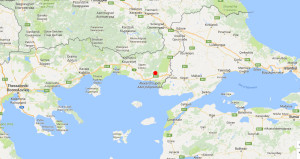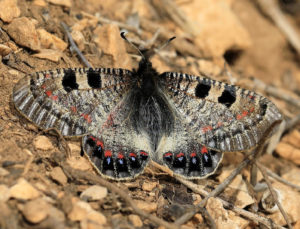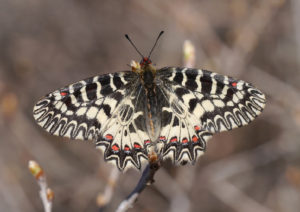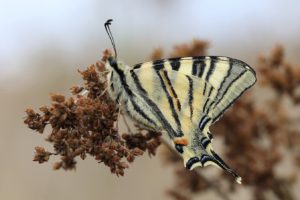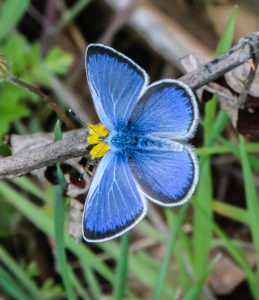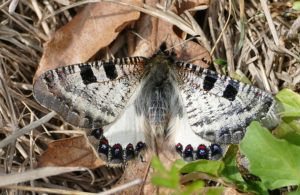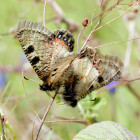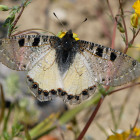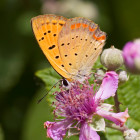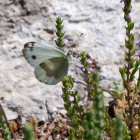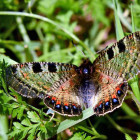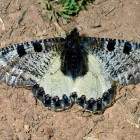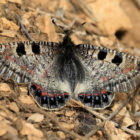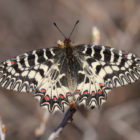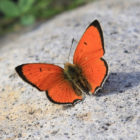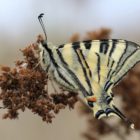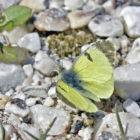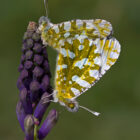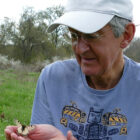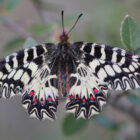Dates & Prices |
BOOK NOW |
Dates: 8th – 15th April 2024 Confirmed departure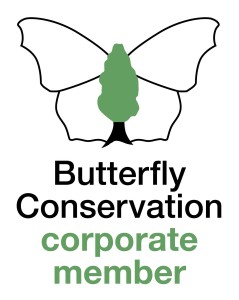
Price: £1,395 Full
Single Room Supplement: £150
Deposit: £150 per person
Price Includes: Accommodation, all meals, ground transport, services of guides, holiday report
Not Included: International flights, travel insurance, drinks & other personal items
Conservation Donation: Butterfly Conservation
Leader(s): Michael de Courcy Williams + second guide for larger group
Group Size & Travel: Minimum 4 & maximum 12 guests + 1-2 leaders.
Grade: Generally easy walking at a very gentle pace
Holiday Highlights
- Look for False Apollo – one of the most beautiful and rare butterflies in Europe!
- Led by local expert Michael de Courcy Williams, who knows the area better than anyone and is the best person to help you see False Apollo in all its finery!
- Numerous other spring butterflies possible such as Eastern & Southern Festoon, Grecian Copper, Gruner’s Orange Tip, Powdered Brimstone, Krueper’s Small White, Eastern Greenish Black Tip, Eastern Wood White, Small Bath White, Eastern Baton Blue etc
- Explore one of the most biodiverse corners of North Greece. Habitats include forests, gorges, groves, rivers, meadows, maquis & a lot more!
- 2 centre tour including a stay in a charming family run hotel for our exploration of Mount Falakro, Mount Orvilos & Nestos Valley
- Tour supports Butterfly Conservation
Join us in Greece for the stunning and rare False Apollo plus lots of other great spring butterflies!
Join us in Greece for the stunning and rare False Apollo plus lots of other great spring butterflies!
Northeast Greece has an exceptional flora and fauna because of its transitional geographic position with influences of the Mediterranean, Anatolian and Euro-Siberian regions. Butterflies of very special importance in the East Rodopi Mountains include strong populations of the geographically restricted and regionally endemic species the False Apollo (Archon apollinus) – our main target for this holiday.
We’ll stay in two locations during the week, having 4 nights based in Alexandroupoli for our main target and to visit other nearby sites for other species, before heading east to stay in a charming family run hotel in the mountain village of Volakas, where we’ll spend the next 3 nights. From here we’ll be perfectly placed to explore some fantastic locations such as Mount Falakro, Mount Orvilos and the Nestos Valley. The extra range of habitats we’ll visit and more easterly location will help add to the number of butterfly species we can hope to encounter.
We will naturally spend a fair amount of time on the False Apollo, but we’ll also enjoy a whole host of other spring butterflies. Eastern Festoon (Zerynthia cerisy), Grecian Copper (Lycaena ottomana) and Southern Festoon (Zerynthia polyxena) are quite common, among other typically southern Balkan and western Anatolian species, including such specialties as Eastern Baton Blue (Scolitantides vicrama), Powdered Brimstone (Gonopteryx farinosa), Eastern Greenish Black-tip (Euchloe penia), Small Bath White (Pontia chlorodice), Krueper’s Small White (Pieris krueperi), Southern Comma (Polygonia egea) and Camberwell Beauty (Nymphalis antiopa). We may also see other early spring species such as Large Tortoiseshell (Nymphalis polychloros), Eastern Dappled White (Euchloe ausonia), Green-underside Blue (Glaucopsyche alexis) and Green Hairstreak (Callophrys rubi).
The Mountains of the Rodopi are a long range that stretches across northeast Greece, where their high peaks form the land border with Bulgaria. Towards the end of the range, the East Rodopi Mountains form a low hilly region known as the Evros Hills and these in turn eventually come down to and meet with the Aegean coastline in a region known as the Ismaros Hills. Much of the area is densely clothed in thermophilous Balkan Oak forest (Quercus frainetto, Q. pubescens & Q. cerris) and these are probably the most expansive tracts of this type of deciduous forest vegetation in Greece. These forests, along with their associated and floristically rich under story, have a high biological and conservation value and are protected within numerous Natura2000 sites (http://natura2000.eea.europa.eu/#).
Dadia National Park, situated on the most easterly section of these forested hills and just inland from the Evros river, along which runs the border between Turkey and Greece, is known internationally for its populations of Eurasian Black Vulture (Aegypius monachus), Griffon Vulture (Gyps fulvus) and Egyptian Vulture (Neophron percnopterus) as well as for its great diversity of resident and migratory birds of prey. Wolves are frequent and have thriving and expanding populations in the complex topography of forested hillsides and valleys.
In addition to oak, coniferous forests of Aleppo Pine (Pinus brutia) occur and at higher altitudes (above 700m) the oak forest grades into Beech forest, here it is mostly Oriental Beech (Fagus sylvatica subspecies orientalis). At lower altitude or in warmer drier areas, shrub communities develop. These include the distinctive Eastern Mediterranean High Maquis with Eastern Strawberry Tree (Arbutus andrachne), recognisable by its characteristic red stems, or a matorral of evergreen oak (Quercus coccifera/Q. ilex), which is most frequent in coastal areas. In low hilly regions a deciduous thorny shrub formation known as a Shiblyak occurs, which is dominated by Oriental Hornbeam (Carpinus orientalis) and Christ’s thorn (Paliurus spina-christi) brushwood.
A noticeable feature throughout the eastern Rodopi Mountains is the occurrence of numerous hill streams along which develop biologically important riverside forests. A very special form is the occurrence of gallery forests of ancient and often massive Oriental Plane (Platanus orientalis). These streamside biotypes add hugely to the biodiversity of the region. Examples of regionally important insects that depend on these forest streams (albeit unlikely to see on the wing at this time of year) include the locally endemic dragonfly, Thracian Emerald (Somatochlora borisi) and the regional endemic Balkan Emerald (S. meridionalis).
The importance of these forests to invertebrates has been little studied but the region has a distinctive fauna with many species that are rare or have otherwise largely disappeared from the European landscape. One example manifestation of this is the occurrence here of some of Europe’s largest and dramatic insects. Europe’s largest moth with a wingspan of 15 cm, the Giant Peacock Moth (Saturinia pyri) is common but of more local occurrence is the rather special heavyweight lasiocampid moth, the Eastern Lappet (Pachypasa otus). Enormous predatory crickets of the genus Saga, sway as if in a breeze as they walk and prey on other crickets, but the large ground dwelling and armour plated genus Callimenus is surely not one of those.
The largest Hemiptera in the world, the Giant Water Bug (Belostomatidae) survives in forest streams in its only European region; the terrifying looking but harmless Mammoth Wasp, Megascolia maculata, which at 5-6 cm length is Europe’s largest wasp, is a parasite of European Rhinoceros Beetle (Oryctes nasicornis). Apart from the Rhinoceros beetle there are many other giant beetles including the wood feeding cerambycids (Aegosoma scabricorne, Cerambyx cerdo, Prinobus myardii, Prionus besikanus & Rhesus serricollis) and the delightfully named Pine Chafer (Polyphylla fullo) can even be seen in downtown Alexandroupoli.
Day 1: Arrival in Thessaloniki and transfer to hotel. If time allows we shall make excursions en route or once we’ve arrived.
Day 2: Evros Hills: (i) Kirki woods – Thermophilous Balkan Oak Forest and deciduous brushwood formations (Shiblyak) and (ii) Platorrachi – Gymnolofos – Wide limestone valley with Balkan oak forest, evergreen oak maquis and gallery forest of ancient Oriental plane trees.
Day 3: Thracian Plain: Evros Delta, Mesembria, Petrota Rocks & Lagofolia – Delta grasslands with scrub woodland, dunes, lagoons and canals, coastal evergreen oak maquis and rocky Mediterranean hillside grassland systems.
Day 4: Ismaros Hills: Maronia – Dramatic granite and limestone headland with ancient organic olive groves, Mediterranean maquis and rocky streamside grasslands overlooking the North Aegean.
Day 5: Transfer from Alexandroupoli – Falakro Mountain (Volakas): Travel from the East to Western Rodope Mountains with a stop over in the Nestos Valley – low altitude limestone evergreen scrub and deciduous formations and rocky gorge with several regional endemic plants.
Day 6: Falakro Mountain: Low altitude rocky grassland, species rich deciduous forest, mid altitude ancient open Black Pine forest with limestone grassland and deep valleys.
Day 7: Orvilos Mountain: Flower rich limestone grasslands up to 2000m with low altitude thermophilous scrub formations and Balkan oak forest.
Days 8: Depart Volakas and transfer to Thessaloniki Airport. If time permits we’ll fit in excursions locally or en route to the airport.
- False Apollo pair
- False Apollo
- Eastern Baton Blue
- Eastern Festoon
- Krueper’s Small White
- False Apollo
- False Apollo
John V, 2022…The False Apollo Tour is great, it is an early spring tour and it is possible to see most of the early spring butterflies and also some that are only found in that part of the world.
Harry F, 2017…Both Michael and Martin were excellent leaders. Michael also shared the benefit of his local knowledge and this was best demonstrated by access to his ‘secret site’ for the target False Apollo, which duly obliged and the tricky seasonal emergence was timed to perfection. This alone made the trip worthwhile, though despite being early in the season we managed a reasonable number of species, and some decent birding was added to the itinerary when weather conditions were less favourable. The hotel was of a very good standard and buffet service at both breakfast and dinner offered a good variety for all tastes.
Denise & Andy Q, 2017… The trip was fantastic! Shame the weather was not always on our side but never mind, we still enjoyed it very much. Thank you Greenwings!


